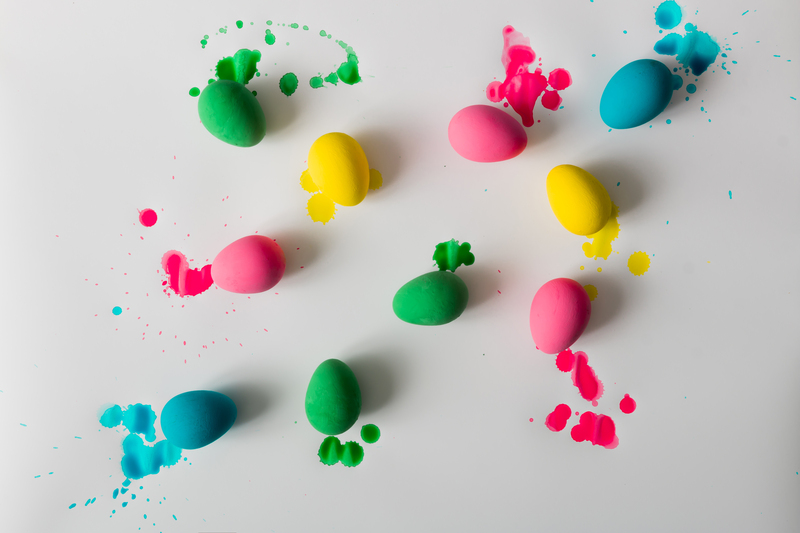Practical Advice for Maintaining a Mold-Free Bathroom
Posted on 31/08/2025
Practical Advice for Maintaining a Mold-Free Bathroom
Bathroom mold is a common, stubborn, and unsightly problem in homes of all sizes and ages. Not only does it create unappealing dark spots and stains, but it can also cause structural damage and trigger health issues, particularly for people with allergies or respiratory problems. Fortunately, with consistent maintenance and smart strategies, you can keep your bathroom a fresh, hygienic, and mold-free sanctuary. In this comprehensive article, we'll explore the best practical advice for maintaining a bathroom free of mold, from the root causes and early signs to effective prevention and deep cleaning methods.
Why Bathrooms Attract Mold
To effectively tackle mold, it's crucial to understand why bathrooms are prone to mold growth. Bathrooms create a perfect environment for mold because they are typically:
- Warm (due to hot showers and baths)
- Moist (because of frequent water use)
- Poorly Ventilated (closed windows and inadequate fans)
Mold spores thrive on organic material--like drywall, wood, grout, or even soap residue--and once they settle, they spread rapidly in a humid environment.

Identifying Early Signs of Bathroom Mold
Keeping your bathroom mold-free starts with vigilance. Common signs of mold in bathrooms include:
- Black, green, or orange spots on grout, tiles, ceilings, or behind sinks
- Persistent musty odors, even after cleaning
- Peeling paint, bubbling wallpaper, or staining on walls and ceilings
- Increased allergy symptoms when using the bathroom
If you spot any of these symptoms, swift action is critical for maintaining a mold-free bathroom.
Step-by-Step Guide: How to Prevent Bathroom Mold
To prevent mold from settling in your bathroom, adopt these comprehensive strategies. These tips not only apply to those fighting current mold growth but also to homeowners interested in avoiding future issues.
1. Control Humidity Levels
- Use a bathroom exhaust fan every time you shower or bathe, and leave it running for at least 20 minutes after use to help remove moisture.
- If you don't have an exhaust fan, open a window or door to create air flow.
- For persistent humidity problems, invest in a small dehumidifier specifically designed for bathrooms.
- Keep relative indoor humidity below 50% if possible (hygrometers are inexpensive and handy for this).
2. Improve Air Circulation
- Keep your bathroom door open when the room is not in use.
- If your bathroom is small or lacks ventilation, place a small fan in the hallway to encourage air flow.
- Regularly check that vents are unclogged and clear of dust and lint.
3. Fix Leaks Promptly
- Inspect under sinks, behind toilets, and around the bathtub or shower for leaking pipes or drips. Even small leaks fuel mold growth.
- Repair cracked tiles and deteriorating grout, as water seeps into unseen areas and keeps them perpetually damp.
- Check your caulking: cracked or missing caulk should be replaced to prevent water infiltration.
4. Clean and Dry Surfaces Regularly
- After every shower or bath, use a squeegee to remove excess water from tiles and glass doors.
- Wipe down countertops and sinks daily to avoid stagnant water.
- Hang up wet towels, bath mats, and washcloths separately so they can dry thoroughly.
- Launder shower curtains and bathroom mats weekly--it's best to use quick-drying, mold-resistant fabrics.
5. Choose Mold-Resistant Materials
- Opt for mold-resistant paint or wallpaper, which includes antimicrobial additives.
- Install tile, glass, or plastic surfaces rather than wood or textile-based finishes.
- Select solid-surface countertops instead of porous options.
- If remodeling, consider using moisture-resistant drywall ("green board") or cement backer boards behind tile work.
6. Mold Prevention Tips for Showers and Bathtubs
Since showers and tubs are the wettest part of your bathroom, they deserve special attention in your mission to maintain a hygienic space:
- Keep shampoo bottles, soap, and razors to a minimum to avoid creating damp, hidden pockets where mold can grow.
- After use, leave shower doors or curtains partially open to allow fresh air to circulate and evaporate excess moisture.
- Install a shower caddy that allows water to drain freely instead of pooling beneath bottles.
How to Clean Mold in the Bathroom: Step-By-Step
Should mold appear despite your diligence, it's vital to act quickly to prevent it from gaining a foothold. Here's a practical guide to removing mold from bathroom surfaces:
1. Safety First
- Wear gloves, an N95 face mask, and goggles to protect yourself from spores.
2. Mold Cleaning Solutions
- Vinegar: Pour undiluted white vinegar into a spray bottle, spray directly onto the mold, let sit for 1 hour, then scrub and rinse.
- Hydrogen Peroxide: Use a 3% hydrogen peroxide solution in a spray bottle, apply to affected areas, let sit for 10 minutes, scrub, and rinse.
- Baking Soda: Mix 1/4 tablespoon with water to make a paste or solution. Scrub onto the mold, let dry, then rinse and dry thoroughly.
- Bleach: For tough areas, mix 1 cup of bleach with 1 gallon of water, apply with care, keeping the area well ventilated. Never mix bleach with ammonia or other cleaners!
3. Scrubbing Techniques
- Use a stiff brush or an old toothbrush to thoroughly scrub grout lines and corners.
- After cleaning, dry the area with a towel or paper towels to remove leftover moisture.
4. Prevent Mold's Return
- After cleaning, treat the surface with a mold-resistant spray or a diluted vinegar solution.
- Adopt the daily maintenance habits discussed above for long-lasting results.
Best Products to Keep Your Bathroom Mold-Free
- Mold-resistant paint: Look for bathroom-specific or "mildew-proof" paints for walls and ceilings.
- Grout sealer: Helps prevent moisture penetration and stains on tile grout lines.
- Bathroom dehumidifier: Designed for small spaces with automatic shutoff features.
- Moisture-absorbing bags or crystals: Ideal for linen closets adjacent to the bathroom or under sinks.
- Mold-resistant shower curtains and liners: Made from quick-drying synthetic materials.
- Mold-prevention sprays: These create an antimicrobial barrier on surfaces for added defense.
How to Design a Mold-Resistant Bathroom
During renovations or new builds, you can make smart choices that help you avoid future mold problems:
- Install a high-powered exhaust fan vented to the outside.
- Design the bathroom with ample natural light; sunlight helps inhibit mold growth.
- Choose non-porous flooring and wall materials such as porcelain, ceramic, or glass tile.
- Ensure all water fixtures are properly sealed and caulked to avoid leaks.
Common Mistakes That Encourage Bathroom Mold
- Ignoring minor leaks or slow drips that build up hidden moisture
- Letting condensation build up on mirrors, windows, or walls without wiping it away
- Failing to clean shower curtains, bathmats, or loofahs regularly
- Using dense fabrics for bathroom mats or curtains that dry slowly
- Over-cluttering shower shelves and corners--which traps water and prevents drying
- Over-reliance on air fresheners to mask musty smells instead of tracking down the source
By paying attention to these potential pitfalls, you give yourself a head start in maintaining a mold-free bathroom for years to come.
Frequently Asked Questions about Bathroom Mold and Mildew
- Is mold in the bathroom dangerous?
Some types of bathroom mold (like black mold) can aggravate allergies or pose a health risk, particularly for the elderly, children, or those with compromised immune systems. Always deal with visible mold promptly. - How often should I clean my bathroom to prevent mold?
High-traffic bathrooms should be wiped down daily, with a thorough cleaning (including scrubbing grout and tiles) at least once per week. - Can I use essential oils to prevent mold?
Certain oils (like tea tree or eucalyptus) have antimicrobial properties and may help, but they should not replace regular cleaning and moisture control practices. - If mold keeps coming back, what should I do?
Persistent mold often means there is a hidden moisture issue, like a leak or poor ventilation. Consider consulting a plumber or mold remediation expert for persistent problems.
Creating an Effective Bathroom Cleaning Routine
The single most important aspect of maintaining a mold-free bathroom is consistency. Here's a sample weekly cleaning routine to keep mold at bay:
- Monday: Wipe down counters and sinks; empty the trash can
- Wednesday: Squeegee and wipe dry all shower and tub surfaces
- Friday: Wash bath mats and towels; swap in clean, dry linens
- Saturday: Deep clean tile grout and scrub toilet, sink, faucet, and tub with a disinfecting cleaner
- Daily: Use the exhaust fan, hang wet towels, and keep clutter to a minimum
By following this routine, you'll dramatically reduce the chance that mold has an opportunity to take root in your bathroom.

Additional Tips for a Mold-Free, Pleasant Bathroom
- Encourage household members to dry off in the tub or shower, reducing water splashes on bathroom floors.
- Store cleaning supplies under the sink or in a nearby closet for regular touch-ups.
- Use air-purifying houseplants (e.g., peace lilies or ferns), but avoid overwatering which can increase humidity.
- Periodically inspect and replace exhaust fans and filters to ensure they're operating at peak efficiency.
Conclusion: Enjoy a Fresh, Mold-Free Bathroom
Achieving and maintaining a mold-free bathroom is within everyone's reach. By controlling moisture, improving ventilation, using mold-resistant materials, and establishing a regular cleaning routine, you can ensure your bathroom remains clean, safe, and inviting. Remember, prevention is always easier than remediation. By taking these simple yet powerful steps now, you'll save time, money, and effort--while enjoying the peace of mind that comes with a truly healthy home.
Want to make your bathroom mold-free once and for all? Start with these tips, and enjoy a brighter, fresher, and healthier bathroom every day!





